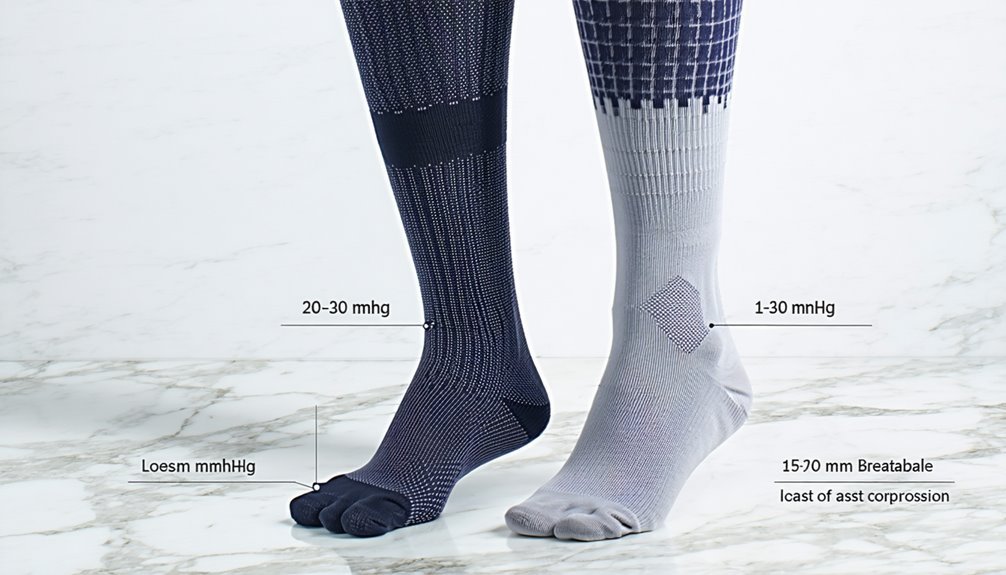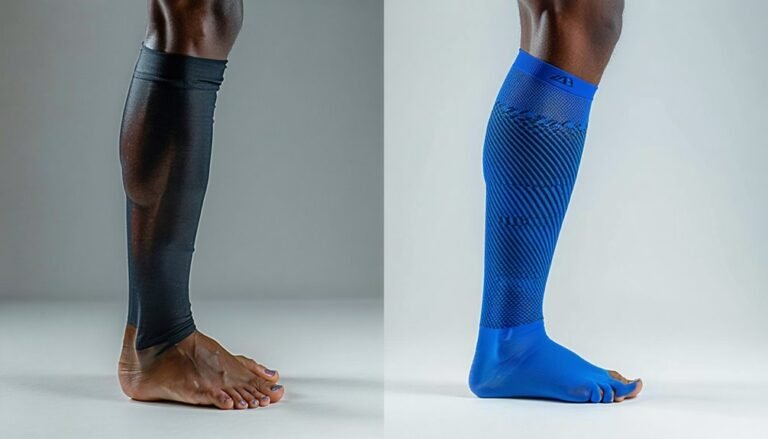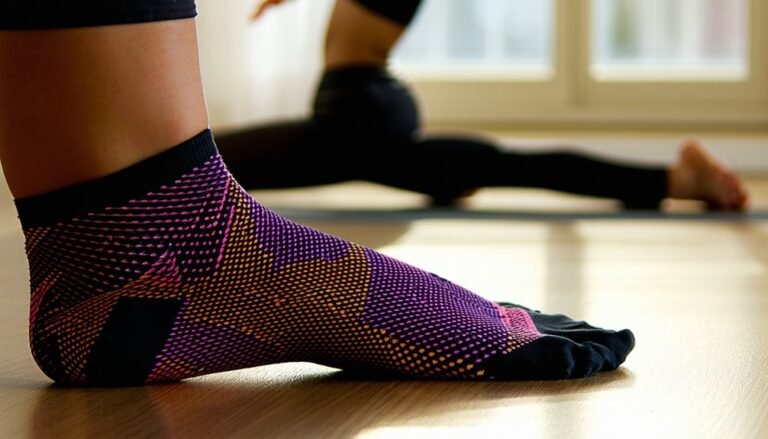Compression Socks 20-30 Mmhg Vs 15-20 Mmhg
When deciding between 15-20 mmHg and 20-30 mmHg compression socks, consider your health needs. The 15-20 mmHg range suits everyday wear, offering comfort and minor swelling relief, while 20-30 mmHg is ideal for significant swelling or medical conditions like chronic venous insufficiency. Proper selection should be guided by a healthcare professional to enhance venous return and prevent complications like deep vein thrombosis. Explore further nuances in compression therapy to tailor the best choice for you.
Understanding Compression Levels
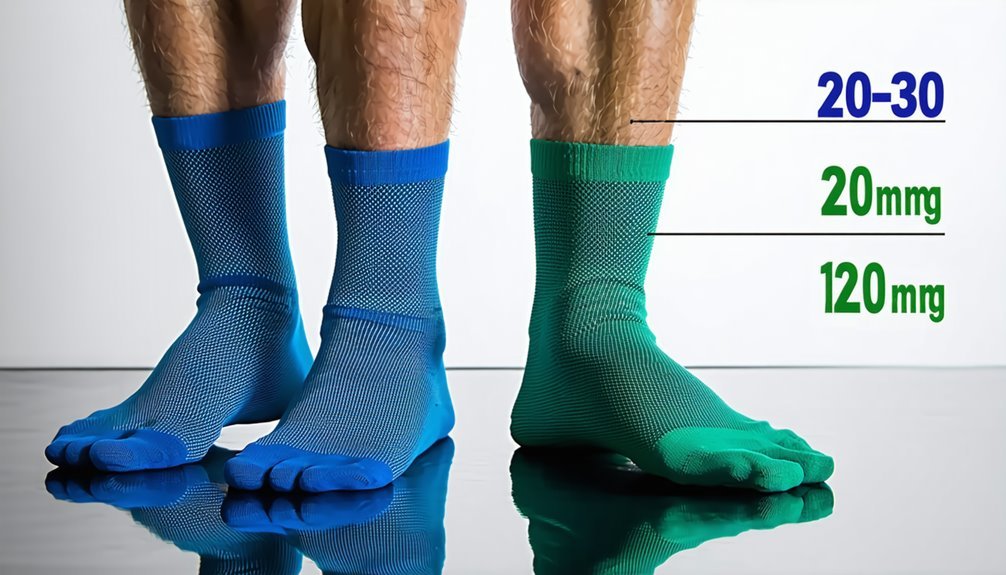
When it comes to compression therapy, understanding compression levels is essential for both efficacy and safety. Compression socks are designed with specific pressure ranges, measured in millimeters of mercury (mmHg), to support venous return and reduce symptoms of venous insufficiency. You should know that compression levels can vary, typically categorized into mild, moderate, firm, and extra firm. For effective treatment, selecting the appropriate pressure range is vital. Firm compression, typically 20-30 mmHg, is often recommended for managing conditions like varicose veins or post-surgical swelling. Conversely, lower compression levels, such as 15-20 mmHg, are geared towards everyday use and mild swelling. Always consult with a healthcare professional to determine the ideal compression level for your specific condition, ensuring both safety and therapeutic benefit.
Benefits of 15-20 Mmhg Compression Socks
When you're considering 15-20 mmHg compression socks, evidence suggests they can considerably enhance blood circulation, reducing the risk of venous disorders. They offer a balance between medical benefit and comfort, making them suitable for daily wear. By improving venous return, these socks can help alleviate minor swelling and discomfort, promoting overall leg health and comfort in your everyday life.
Improved Blood Circulation
Although often overlooked, 15-20 mmHg compression socks play an essential role in enhancing venous return, thereby improving blood circulation. By applying gentle pressure, these socks help maintain ideal venous health, promoting circulatory support vital for your well-being. They encourage the upward movement of blood from the lower extremities back to the heart, reducing the risk of venous stagnation. For individuals seeking preventative care or managing mild symptoms related to venous insufficiency, these socks provide a safe, non-invasive option. Evidence suggests that consistent use can alleviate minor swelling, fatigue, and discomfort associated with prolonged standing or sitting. Prioritizing your circulatory health through the use of 15-20 mmHg compression socks can contribute to overall vascular wellness, ensuring you stay safe and comfortable.
Everyday Comfort Benefits
If you're looking for everyday comfort, 15-20 mmHg compression socks offer a perfect balance of support and ease. These socks are ideal for everyday use, providing moderate compression that enhances venous return without compromising comfort levels. They're designed with your well-being in mind, guaranteeing safety and efficacy with prolonged wear.
Here's a quick look at the benefits:
| Feature | Benefit |
|---|---|
| Moderate Compression | Optimizes circulation for daily activities |
| Comfort-Focused Design | Guarantees prolonged wear without discomfort |
| Versatile Use | Suitable for various daily scenarios |
Medical evidence supports their use for reducing mild swelling and fatigue, making them a safe choice for those on their feet for extended periods. Prioritizing your comfort and circulatory health has never been easier with these compression socks.
Benefits of 20-30 Mmhg Compression Socks
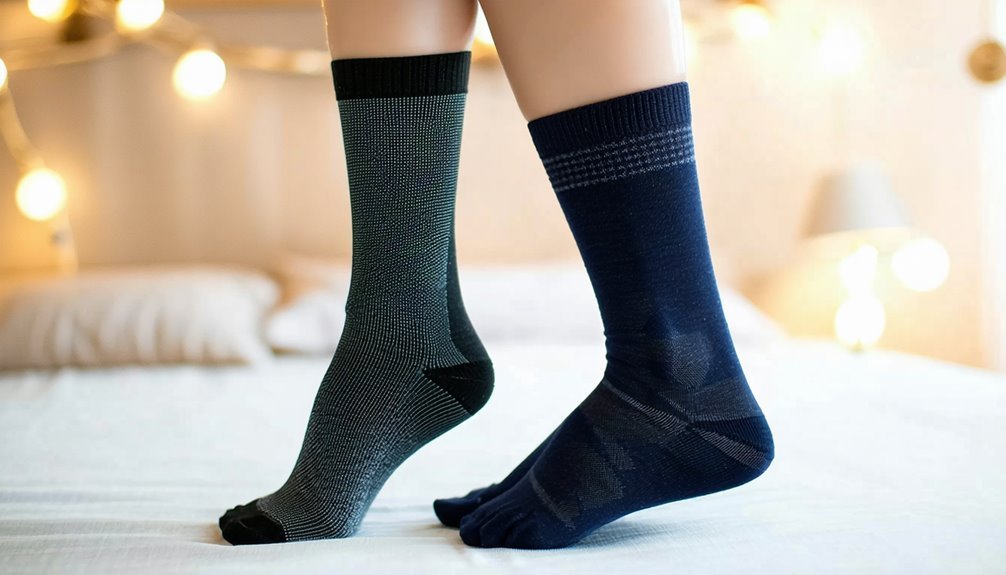
For individuals seeking effective relief from moderate to severe leg discomfort, 20-30 mmHg compression socks offer substantial benefits. These socks provide targeted support to enhance venous return, reducing symptoms like swelling and fatigue. The higher compression level is designed for performance enhancement, making it beneficial for those who spend extended periods on their feet or have circulatory challenges. By applying precise pressure gradients, these socks improve blood flow efficiency, minimizing the risk of venous insufficiency and deep vein thrombosis. The medical-grade compression delivers a balance of comfort and efficacy, ensuring safety while promoting leg health. Whether you're managing chronic conditions or seeking to optimize physical activity, these socks offer a reliable solution for maintaining vascular integrity and overall well-being.
Choosing the Right Compression Level for Athletes
When selecting the appropriate compression level for athletic performance, you'll want to take into account the specific physiological benefits each pressure range offers. Evidence suggests that 15-20 mmHg may enhance circulation and reduce fatigue for light to moderate activities, while 20-30 mmHg can provide superior support during high-intensity exertions. It's essential to assess your individual needs and consult with a healthcare professional to optimize your athletic outcomes and minimize the risk of injury.
Compression Benefits for Athletes
Although the choice of compression level can be perplexing, it's vital for athletes to understand the benefits each level offers to enhance performance and recovery. Compression socks at 15-20 mmHg provide moderate pressure, promoting blood flow and optimizing oxygen delivery, aiding muscle recovery post-exercise. This level is ideal for less intense activities or recovery phases, guaranteeing safety while enhancing performance.
For those engaging in more strenuous activities, 20-30 mmHg offers a higher compression level, reducing muscle oscillation and fatigue. This aids in performance enhancement by stabilizing muscles, diminishing soreness, and accelerating recovery. Evidence suggests that selecting the appropriate compression level can greatly improve athletic outcomes. Prioritize safety by consulting with a healthcare provider to guarantee your compression choice aligns with your specific needs.
Optimal Pressure Selection
Selecting the ideal compression level is essential for athletes seeking to maximize performance and recovery. Understanding the pressure suitability for your specific activity level can greatly impact your results. Here's how to choose wisely:
- Light Activity: If your routine involves walking or light jogging, a lower compression level of 15-20 mmHg is generally suitable, providing sufficient support without excessive pressure.
- Moderate Exercise: For activities like cycling or running, consider 20-30 mmHg to enhance circulation and reduce muscle fatigue.
- High-Intensity Training: Engaging in intense sports may require higher pressure to aid recovery, but consult a healthcare professional for personalized advice.
- Medical Conditions: If you're managing conditions like chronic venous insufficiency, professional guidance guarantees safety and efficacy in pressure selection.
Compression Socks for Travel: Which Level Is Best?
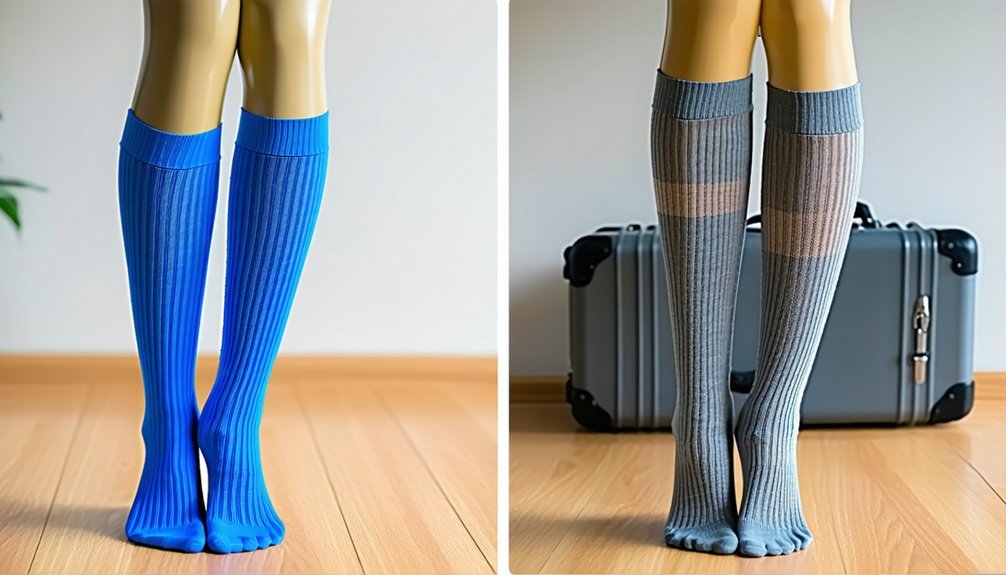
Ever wonder which compression sock level is best for travel? When flying or on long journeys, ensuring proper venous return is essential to reduce the risk of deep vein thrombosis (DVT). For most travelers, a compression level of 15-20 mmHg is typically recommended. This moderate pressure is sufficient to enhance circulation without causing discomfort, making it a popular choice in travel tips for safety-focused individuals. However, if you have specific compression preferences or a history of venous issues, consult a healthcare provider to determine if a higher level, such as 20-30 mmHg, is appropriate. Remember, selecting the right compression level can enhance comfort and reduce risks during travel, aligning with patient-focused care and evidence-based recommendations.
Managing Medical Conditions With Compression Socks
When managing medical conditions like chronic venous insufficiency, varicose veins, or lymphedema, compression socks play an essential role in treatment plans. These specialized garments apply pressure to your legs, promoting venous return and reducing swelling. Understanding the appropriate compression level is key to guaranteeing safety and effectiveness. Here's what you should consider:
- Medical Conditions: Conditions like varicose veins might benefit from 15-20 mmHg, while severe cases often require 20-30 mmHg.
- Consultation: Always consult a healthcare professional before selecting a compression level to avoid complications.
- Proper Fit: Confirm socks fit well to prevent discomfort or impaired circulation.
- Compliance: Regular use as directed by your healthcare provider improves outcomes.
Compression socks can enhance comfort and mobility when used correctly.
Post-Surgical Recovery and Compression Needs
While undergoing post-surgical recovery, compression socks can be an essential component of your healing process. Compression therapy helps reduce swelling and prevents deep vein thrombosis (DVT), enhancing circulation during post-surgery recovery. Studies indicate that wearing compression socks with 20-30 mmHg pressure considerably improves venous return, thereby optimizing recovery outcomes. However, for less severe cases, 15-20 mmHg might suffice, offering gentle support without compromising comfort.
Your physician will guide you in selecting the appropriate compression level based on surgical intervention and individual health needs. Safe and effective use of compression socks is crucial; they should fit snugly but not restrict blood flow. Always follow medical advice to guarantee that compression therapy complements your recovery, promoting faster and safer healing.
Factors to Consider When Selecting Compression Socks
Selecting the right compression socks involves considering several important factors to guarantee they meet your specific medical needs. It's vital to prioritize safety and confirm the socks provide effective therapeutic benefits. Key considerations include:
- Compression Sock Materials: Choose materials that offer breathability and moisture-wicking properties to prevent skin irritation and discomfort. High-quality fabrics like nylon or spandex can enhance durability and elasticity.
- Size Selection Considerations: Proper sizing is important for ideal compression. Use precise measurements of your ankle, calf, and leg length to confirm a snug fit without restricting circulation.
- Compression Level: Depending on your condition, select between 15-20 mmHg for mild swelling or 20-30 mmHg for more significant venous issues.
- Medical Consultation: Always consult your healthcare provider to determine the appropriate compression level tailored to your health requirements.
Tips for Proper Use and Care of Compression Socks
Understanding the factors that influence the choice of compression socks is just the beginning; making sure you use and care for them properly is equally important for maximizing their therapeutic benefits. Start by adhering to proper washing guidelines: use mild detergent, cold water, and avoid bleach to maintain elasticity and prevent fabric deterioration. Air-dry them instead of using a tumble dryer. Implement proper storing techniques by making sure socks are dry before folding or rolling them gently; store in a cool, dry place away from direct sunlight to preserve their compression effectiveness. Always inspect for wear and tear, as compromised socks can reduce their efficiency. By following these evidence-based practices, you'll make sure of the best safety and durability of your compression socks.
Frequently Asked Questions
Can Compression Socks Be Worn Overnight?
You're wondering if wearing compression socks overnight is safe. Follow night usage guidelines: consult your doctor for personalized advice. Compression socks' benefits vary; overnight wear can increase circulation for some, but others may risk discomfort or skin issues.
How Do Compression Socks Help With Swelling?
Compression socks aid swelling reduction by applying consistent pressure, encouraging venous return and improving circulation. This process helps prevent fluid accumulation in tissues, promoting safety and comfort. They're effective for managing edema and ensuring ideal vascular health.
Are There Specific Brands Recommended for Compression Socks?
When you're drowning in endless brand comparisons, look for evidence-based options like Sigvaris or Jobst. These brands offer high-quality sock materials that prioritize your safety and comfort, ensuring ideal compression therapy for your needs. Choose wisely!
Do Compression Socks Come in Different Colors and Styles?
You'll find compression socks in a variety of fashion options and color choices, ensuring both therapeutic benefits and style. Evidence suggests that wearing appealing socks can improve compliance, so select colors and styles that suit your preferences for safety.
How Long Should Compression Socks Be Worn Each Day?
Ironically, comfort's a daily duration concern, right? You'd wear compression socks based on recommended usage—typically for 6-8 hours, ensuring your veins are supported. Consult your healthcare provider for personalized guidance, ensuring ideal safety and effectiveness.

